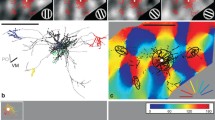Summary
The receptive field organization of simple cells was studied by analyzing interaction effects between two stationary flashing light stimuli. One stimulus was positioned in the most responsive part of the receptive field to produce activity against which the effects of the other stimulus in various positions of the visual field could be determined.
The receptive field was subdivided into an elongated center and elongated antagonistic flanks. The effects on the flanks were always considerably stronger on one side. Powerful flank suppression could be elicited within a region which usually was only slightly wider than the receptive field center. The suppression was just as stimulus specific as the activation of the center and occurred only by light ON or OFF. The cells were classified into ON-dominant and OFF-dominant depending on the kind of response found in the center. In ON-dominant cells the strong flank suppression occurred only by light ON, and light OFF produced enhancement. Correspondingly, the strong flank suppression occurred only by light OFF in OFF-dominant cells.
This is consistent with the interpretation that simple cells have excitatory and inhibitory input from the same type of cells in the lateral geniculate nucleus (LGN), i.e., only from ON-center or OFF-center cells. The small size of the area where strong flank suppression occurred shows that inhibition comes from a few LGN cells rather than from a large pool of cells.
A model for simple cell receptive fields presuming overlapping but acentric excitatory and inhibitory fields with input to both fields from either ON- or OFF-center LGN cells was tested by computer simulation and shown to fit the experimental data.
Similar content being viewed by others
References
Barlow HB, Blakemore C, Pettigrew JD (1967) The neural mechanism of binocular depth discrimination. J Physiol (Lond) 193: 327–342
Benevento LA, Creutzfeldt OD, Kuhnt U (1972) Significance of intracortical inhibition in the visual cortex. Nature New Biol 238: 124–126
Bishop PO, Coombs JS, Henry GH (1971a) Responses to visual contours: spatio-temporal aspects of excitation in the receptive fields of simple striate neurones. J Physiol (Lond) 219: 625–657
Bishop PO, Coombs JS, Henry GH (1971b) Interaction effects of visual contours on the discharge frequency of simple striate neurones. J Physiol (Lond) 219: 659–687
Bishop PO, Henry GH, Smith CJ (1971c) Binocular interaction fields of single units in the cat striate cortex. J Physiol (Lond) 216: 39–68
Bishop PO, Coombs JS, Henry GH (1973) Receptive fields of simple cells in the cat striate cortex. J Physiol (Lond) 231: 31–60
Blakemore C, Tobin EA (1972) Lateral inhibition between orientation detectors in the cat's visual cortex. Exp Brain Res 15: 439–440
Creutzfeldt OD, Innocenti GM, Brooks D (1974a) Vertical organization in the visual cortex (Area 17) in the cat. Exp Brain Res 21: 315–336
Creutzfeldt OD, Ito M (1968) Functional synaptic organization of primary visual cortex neurones in the cat. Exp Brain Res 6: 324–352
Creutzfeldt OD, Kuhnt U, Benevento LA (1974b) An intracellular analysis of visual cortical neurones to moving stimuli. Responses in a co-operative neuronal network. Exp Brain Res 21: 251–274
Dreher B (1972) Hypercomplex cells in the cat's striate cortex. Invest Ophthalmol 11: 355–356
Dreher B, Sanderson KJ (1973) Receptive field analysis. Responses to moving visual contours by single lateral geniculate neurones in the cat. J Physiol (Lond) 234: 95–118
Fries W, Albus K (1976) Static and dynamic properties of receptive fields of some simple cells in cat's striate cortex. Vision Res 16: 563–566
Fries W, Albus K, Creutzfeldt OD (1977) Effects of interacting visual patterns on single cell responses in cat's striate cortex. Vision Res 17: 1001–1008
Goodwin AW, Henry GH, Bishop PO (1975) Direction selectivity of simple striate cells: Properties and mechanism. J Neurophysiol 38: 1500–1523
Heggelund P, Albus K (1978) Response variability and orientation discrimination of single cells in striate cortex of cat. Exp Brain Res 32: 197–211
Henry GH (1977) Receptive field classes of cells in the striate cortex of the cat. Brain Res 133: 1–28
Henry GH, Bishop PO, Coombs JS (1969) Inhibitory and subliminal excitatory receptive fields of simple units in cat striate cortex. Vision Res 9: 1289–1296
Hubel DH, Wiesel TN (1962) Receptive fields, binocular interaction, and functional architecture in the cat's visual cortex. J Physiol (Lond) 160: 106–154
Innocenti GM, Fiore L (1974) Post-synaptic inhibitory components of the responses to moving stimuli in area 17. Brain Res 80: 122–126
Lee BB, Cleland BG, Creutzfeldt OD (1977) The retinal input to cells in Area 17 of the cat's cortex. Exp Brain Res 30: 527–538
Maffei L, Fiorentini A (1976) The unresponsive regions of cortical receptive fields. Vision Res 16: 1131–1139
Mifova LL (1977) Characteristics of inhibition in receptive fields of the cat visual cortex. Neirofiziologiya 9: 261–268
Nelson JI, Frost BJ (1978) Orientation selective inhibition beyond the classical visual receptive field. Brain Res 139: 359–365
Nothdurft HC (1976) Spatial resolution and nonlinearities of simple cells in the cat visual cortex measured with parallel line pairs. Biol Cybernetics 24: 153–163
Schiller PH, Finlay BL, Volman SF (1976) Quantitative studies of single-cell properties in monkey striate cortex. I. Spatiotemporal organization of receptive fields. J Neurophysiol 39: 1288–1319
Tsumoto T, Eckart W, Creutzfeldt OD (1979) Modification of orientation sensitivity of visual cortex neurons by removal of GABA-mediated inhibition. Exp Brain Res 34: 351–363
Wilson JR, Sherman SM (1976) Receptive field characteristics of neurons in cat striate cortex: changes with visual field eccentricity. J Neurophysiol 39: 512–533
Author information
Authors and Affiliations
Additional information
The project was financially supported by the Norwegian Research Council for Science and the Humanities
Rights and permissions
About this article
Cite this article
Heggelund, P. Receptive field organization of simple cells in cat striate cortex. Exp Brain Res 42, 89–98 (1981). https://doi.org/10.1007/BF00235733
Received:
Issue Date:
DOI: https://doi.org/10.1007/BF00235733




